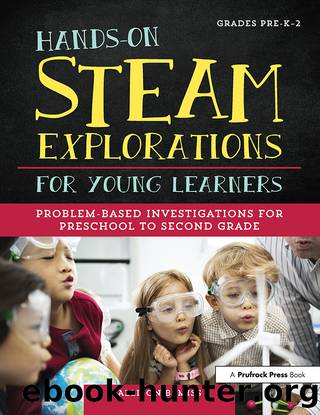Hands-On STEAM Explorations for Young Learners by Allison Bemiss

Author:Allison Bemiss
Language: eng
Format: epub
Publisher: Taylor and Francis
Published: 2018-01-15T00:00:00+00:00
Investigation Procedure
Tell students: A catapult is an invention that is used to launch something in the air. Today we will use what we've learned about levers to create a catapult to help Mr. Eli the Elephant. How do you think we can use this beam(hold up the craft stick) and one of these fulcrums (hold up cylinders like corks, marker caps, and glue sticks) to make our elephants (hold up the gray pom-poms) jump over the fence? Let them discuss ideas with a partner. Students may mention using the beam like a bat; remind them they have to use all three parts: the craft stick, cylinder, and pom-pom.
Introduce the catchphrase "I think if . . ." to the students by modeling some of the ideas you hear them share in the partner talk. For example: "I think if we put the glue stick under the craft stick, it will work like a seesaw." Tell them this catchphrase helps them learn to plan and share ideas.
Say: Now that you've learned a little about levers, you are ready to play and investigate to help us learn how to get Mr. Eli the Elephant over the fence. Remember you are going to explore with your smaller materials, and at the end of the class we will make a plan to get our larger elephant over the fence (or the chair).
Have students work in partners or small groups to come up with their first "I think if . . ." statement that will help them get started with the investigation. For example: "I think if we put the cotton ball in the cap on the craft stick, it will help the elephant hold still while we launch it."
Distribute materials and copies of Handout 5.1:Student's Toolbox. Then have students play, explore, and investigate. Students will try things that do not work. As long as they are following the safety rules, this is okay. If students are stuck, or having a hard time getting the elephant to fly, you can encourage them to take a Scientist Stroll around the classroom to scout and learn from others' ideas. Once they have done this, have them share with you an "I think if . . ." plan and get back to exploring.
As you walk around, help students understand how forces play an important role in this investigation. The students input force on one side of the lever to make the pom-pom fly. Gravity pulls the pom-pom back to the ground.
If students finish early, give them more blocks and ask them to do another test to try to get the elephant over a higher fence.
As students finish, have them clean up the materials and then give them copies of Handout 5.2:Elephant Catapult Recording Sheet. Tell the students to reflect or remember back to what method worked the best for them to get the elephant over the fence. Ask them to draw a picture or diagram that shares how they believe the class should create the lever to catapult the elephant over the chair.
Download
This site does not store any files on its server. We only index and link to content provided by other sites. Please contact the content providers to delete copyright contents if any and email us, we'll remove relevant links or contents immediately.
| Arts & Humanities | Health |
| Language Arts | Library Skills |
| Mathematics | Reading & Phonics |
| Science & Technology | Social Studies |
The Art of Coaching Workbook by Elena Aguilar(48422)
Trainspotting by Irvine Welsh(20117)
Twilight of the Idols With the Antichrist and Ecce Homo by Friedrich Nietzsche(17736)
Fangirl by Rainbow Rowell(7874)
Periodization Training for Sports by Tudor Bompa(7361)
Change Your Questions, Change Your Life by Marilee Adams(6685)
This Is How You Lose Her by Junot Diaz(5829)
Grit by Angela Duckworth(4760)
Red Sparrow by Jason Matthews(4719)
Asking the Right Questions: A Guide to Critical Thinking by M. Neil Browne & Stuart M. Keeley(4626)
Paper Towns by Green John(4193)
Room 212 by Kate Stewart(4137)
Ken Follett - World without end by Ken Follett(3992)
The Sports Rules Book by Human Kinetics(3616)
Housekeeping by Marilynne Robinson(3443)
The Motorcycle Diaries by Ernesto Che Guevara(3364)
Introduction to Kinesiology by Shirl J. Hoffman(3317)
Exercise Technique Manual for Resistance Training by National Strength & Conditioning Association(3317)
Double Down (Diary of a Wimpy Kid Book 11) by Jeff Kinney(3302)
